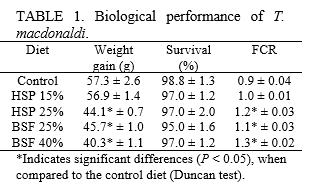PERFORMANCE OF JUVENILE TOTOABA Totoaba macdonaldi FED HYDROLYZED SOY PROTEIN AND BLACK SOLDIER FLY Hermetia illucens LARVAE MEALS, IN PLACE OF DIETARY FISHMEAL
The search for feedstuffs alternative to fishmeal continues to be a priority for the aquaculture industry. Among them, soy protein has been extensively investigated, but the presence of anti-nutritional factors and amino acid imbalances h ave limited its inclusion. However, processing techniques, such as enzymatic hydrolysis and heat treatment, may help remove or inactivate anti- nutrients and break down protein into small peptides. Hydrolyzed soy protein (HSP) has been shown to improve growth and survival of fish. Another interesting alternative feedstuff is black soldier fly (BSF) (Hermetia illucens ) larvae meal, which has recently been identified as an excellent protein source for farmed fish and crustaceans. Totoaba (Totoaba macdonaldi), a carnivorous marine fish endemic to the Gulf of California in Mexico , has been targeted for aquaculture mainly due to its fast growth rate and meat quality. The present study evaluated the use HSP and BSF meals as substitutes for fishmeal in diets for totoaba.
A control diet was formulated to contain 50% crude protein and 14 % crude fat, using fishmeal as the main protein source. Then, 15 and 25% of fishmeal was replaced by HSP meal . Also, 25 and 40% of fishmeal was replaced by BSF meal. Juvenile T. macdonaldi (2.5 ± 0.03 g, overall initial mean weight) were reared in a recirculating aquaculture system consisting of 250-L tanks, with four replicate tanks per treatment, and a stock ing density of 100 fish/m3. Fish were fed the experimental diets to apparent satiation for 7 weeks. Results indicate that HSP meal is an adequate source of nutrients for totoaba when used to replace 15% of fishmeal, resulting in good growth, survival, and f eed conversion ratio (FCR) (Table 1) . In contrast, growth and feed utilization of fish fed 25% HSP meal and 25 or 40% BSF meal were significantly inferior ( P <0.05) to those of fish fed the control diet. This is, to our knowledge, the
first report on the use of BSF meal in diets for totoaba. Despite the fact that these results were not encouraging , further research should be c onducted testing BSF meal levels below 25% , and perhaps incorporating a prior hydrolysis treatment for BSF meal.
In conclusion, the results of the present study indicate that fishmeal can be partially replaced by HSP meal without negatively affecting growth of juvenile totoaba.
